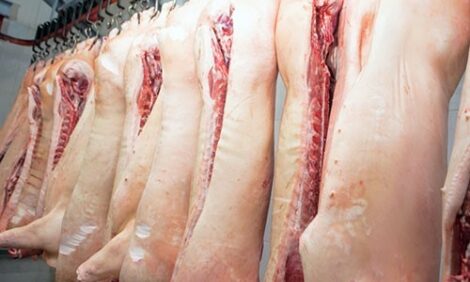



New Pestivirus That Attacks Nervous System of Austrian Pigs
AUSTRIA - Some newly born piglets shiver even when they are kept warm. So-called "shaking piglets" have symptoms that resemble those of the classical swine fever, with extensive damage to the brain and the spinal cord.The viral origin of the disease was clarified only recently with the discovery in Europe and the USA of an atypical porcine pestivirus. Researchers at the Vetmeduni Vienna have now discovered a further new virus in shaking piglets on an Austrian farm.
The pathogenic agent is related to the Australian Bungowannah virus and more distantly to the classical swine fewer virus. Because of the symptoms it causes, the new virus is termed LINDA virus (Lateral shaking Inducing NeuroDegenerative Agent).
Its discovery was recently announced in the journal Emerging Infectious Diseases. In 2015, an Austrian pig breeder observed a number of new-born "shaking piglets" on his farm. Such piglets suffer from a disease in which heavy damage to the brain and spinal cord causes severe shaking.
The condition is associated with huge financial losses for the farm. It is believed to be caused by an atypical porcine pestivirus (APPV) that was recently discovered in Europe and the USA. Scientists at the Vetmeduni Vienna have subsequently found the virus in Austria.
Because of the pronounced symptoms on this particular farm, experts at the University Clinic for Swine checked whether the animals were infected with the recently described APPV. Despite comprehensive and highly specific tests, neither APPV nor another pathogen known to cause the disease could be found.
However, the symptoms and the results suggested that a pestivirus was somehow involved, so the scientists designed a new type of diagnostic test that ultimately led to the discovery of a new pestivirus.
Unknown pestivirus found in Austrian "shaking piglets"
"The new PCR assay our team developed recognized all known pestiviruses," explains Benjamin Lamp of the Institute of Virology, "and so enabled us to detect a virus that was previously unknown." The complete analysis of the organization of the genome (the RNA structure) and characteristic proteins clearly showed that the newly discovered pathogen is a pestivirus from the family of Flaviviridae.
Because of the sideways shivering and the lesions in the nerve tissues of affected piglets, the virus was named LINDA (Lateral shaking Inducing NeuroDegenerative Agent). "Pestiviruses are known to infect foetuses of pigs, sheep and cattle, often targeting the central nervous system. But pestiviral infections are widespread only in hoofed animals and so not at all dangerous to humans," says Dr Lamp.
The team also used classical cell-culture methods to cultivate the Linda virus from tissue samples. "This will be important to enable us to continue to study the new virus."
The Linda virus has dangerous relations
It is unknown how widespread the new Linda virus is in the swine population." We are currently developing a serological test to learn more about the prevalence of the Linda virus in Austria, i.e. about the number of piglets it infects," says Dr Lamp.
"The test will be important because analysis of the virus has shown that it is distantly related to the virus that causes classical swine fever. We cannot exclude the possibility that it might interfere with the official tests for swine fever."
In addition, it is unclear how much of a danger the newly discovered virus poses for pig breeding. The Spanish word "linda" is usually translated as "pretty" or "cute" but there is nothing pretty or cute about the newly discovered Linda virus.
Till Rümenapf, the Head of the Institute, notes that "Because it also infects the uterus of pregnant sows, the Linda virus could disrupt the development of the piglets' cerebral cortex, like infection with the Zika virus. However, we should remember that the closest genetic relative of our new virus is an Australian."
Dr Rümenapf points to the phylogenetic analysis, which shows that Linda is related to the Bungowannah virus, described in Australia in 2006. This pathogen has to date been found only on two neighbouring farms in Australia, where it led to the death of over 50,000 animals.
Although extensive measures managed to prevent the further spread of the virus, the two farms did not recover from the outbreak. Once pigs are infected, the virus remains in their bodies, so infected pigs can continue to release the virus for a long time and are extremely contagious to other pigs.
Infection of the uterus with the Bungowannah virus leads to abortion and a high mortality among piglets, generally caused by a viral infection of the heart muscle. However, no neurological damage or "shaking piglets" were observed.








